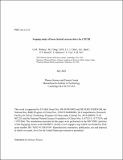Scoping study of lower hybrid current drive for CFETR
Author(s)
Wallace, Greg M.; Ding, B.J.; Li, M.H.; Chen, J.; Baek, Seung Gyou; Bonoli, Paul T.; Shiraiwa, S.; Liu, L.; Wu, C.B.; ... Show more Show less
Download21ja016_full.pdf (2.095Mb)
Metadata
Show full item recordAbstract
The paper assesses the applicability of lower hybrid current drive (LHCD) for two potential operating scenarios for the China Fusion Engineering Test Reactor (CFETR): the “hybrid” scenario in which some of the plasma current is sustained by the Ohmic transformer, and the fully non-inductive “steady state” scenario. The πScope workflow engine was used to set up a large number of ray tracing/Fokker- Planck simulations (> 10^4) with parametric scans in the antenna poloidal position and launched parallel refractive index (n||) for both the hybrid and steady state scenarios. Modeling predicts efficient off-axis current drive (1.3 MA for 20 MW launched power) with a peak near ρ of 0.6-0.65 for waves launched from the high field side (HFS). Waves launched from the low field side (LFS) damp at larger radius (ρ > 0.73) with similar efficiency to HFS launch. Stability analysis of the CFETR scenarios favors current drive profiles peaked near the mid-radius, suggesting that HFS launch is preferable due to the current drive location. The effect of wave scattering from density blobs in the edge/scrape-off-layer region was assessed through rotation of the perpendicular wavenumber at the ray origin. Simulations show that this effect can be quite large both in efficiency and damping location, however by adjusting the launched n|| much of the unperturbed performance can be recovered.
Description
Submitted for publication in Nuclear Fusion
Date issued
2021-07Department
Massachusetts Institute of Technology. Plasma Science and Fusion CenterJournal
Nuclear Fusion
Publisher
IOP
Other identifiers
21ja016